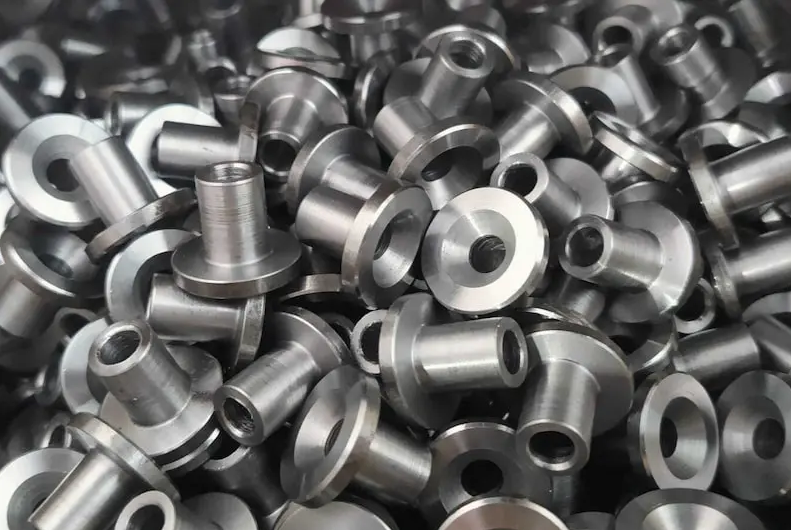CNC Machining Cost for Small Batch Aluminum Parts
 Feb 10,2025
Feb 10,2025

CNC machining is a modern manufacturing process that creates precise components from materials like aluminum. This method is ideal for low-volume production, where small quantities of high-quality parts are needed.
However, sometimes, manufacturers and buyers often wonder: what affects the cost of CNC machining for small batch aluminum parts, and how can these costs be managed?
In this article, we'll look at the main cost factors, how new technology can improve efficiency, and ways to reduce expenses without lowering quality.

Introduction to CNC Machining for Small Batch Aluminum Parts
What Is Small Batch CNC Machining?
As its name said, small batch CNC machining produces a limited number of parts—often just a few dozen or a few hundred. It's commonly used for prototypes, unique components, and low-volume production runs. Small batch CNC machining is known for its flexibility and accuracy. However, it can be more expensive because costs are not spread across a large number of parts.
Why Cost Matters for Small Batch CNC Machining
For any processing production, factors affecting cost price are often crucial. Small batch runs often have higher per-part costs while compared to large-scale production. These higher costs come from setup time, tooling, and limited machine runs.
Despite this, small batch CNC machining is still valuable because it produces parts that are difficult or impossible to mass-produce. Because of this, it can meet many small-batch production tasks with high requirements.
Key Factors Affecting CNC Machining Costs for Small Batch Aluminum Parts
As a common processing material, aluminum has always been one of the first choices for many CNC machining. Next, we will have an in-depth understanding of various aspects that affect price factors:
Aluminum Alloys and Their Costs:
- 6061 Aluminum:
As the king of cost-effectiveness, 6061 is the top choice for many. It is often the go-to alloy for many industrial applications. It provides a good balance of mechanical properties and corrosion resistance at a relatively affordable cost. Its machinability and weldability also make it a popular choice for general engineering and structural components.
- 7075 Aluminum:
As a high-strength alloy, 7075 has better mechanical properties than 6061, making it more expensive. 7075 is often used in aerospace and military applications (where material requirements are extremely high); because it provides exceptional tensile strength and durability.
- 5052 Aluminum:
5052 is a popular choice thanks to its excellent corrosion resistance, especially in marine settings. While it's a bit more expensive than 6061, it's also more flexible and holds up better under tough conditions. That's why you'll often find it used for things like chemical tanks, pressure vessels, and marine parts
- Other Common Alloys:
Alloys such as 2024 and 3003 also play a role in specific applications. 2024 offers excellent strength but limited corrosion resistance, making it suitable for aerospace use where surface treatments can be applied.
On the other hand, 3003 is a low-cost option ideal for applications that don't require high strength, such as storage tanks or lightweight structures.
Sourcing Considerations:
The source of aluminum also impacts cost. Local suppliers can often provide competitive pricing, lower transportation fees, and faster delivery times. However, if you need to source materials internationally, be aware that shipping fees, tariffs, and customs duties can significantly increase the overall expense.
This is especially true for high-grade alloys like 7075, where the added cost of international logistics may offset the potential savings from purchasing abroad.
Detailed Comparison of Aluminum Alloys:
To illustrate the differences between these commonly used alloys, here is a table summarizing their typical properties and cost-related factors:
|
Alloy |
Cost Range (Per Pound) |
Tensile Strength (MPa) |
Yield Strength (MPa) |
Corrosion Resistance |
Machinability |
Common Applications |
|
6061 |
$2.00–$3.50 |
190–290 |
240–275 |
Good |
Excellent |
Structural components, frames, general engineering |
|
7075 |
$5.00–$8.00 |
510–570 |
430–505 |
Moderate |
Good |
Aerospace parts, military hardware, high-performance equipment |
|
5052 |
$2.50–$4.00 |
210–290 |
200–250 |
Excellent |
Fair |
Marine components, chemical tanks, transport equipment |
|
2024 |
$4.00–$6.00 |
470–500 |
350–450 |
Poor |
Good |
Aerospace fittings, high-strength components |
|
3003 |
$1.50–$2.50 |
115–145 |
90–125 |
Excellent |
Good |
Storage tanks, decorative elements, roofing |
This comparison highlights that the choice of alloy depends not only on cost but also on the specific performance requirements of the application. By carefully selecting the most suitable alloy and sourcing method, manufacturers can balance quality and cost to optimize their CNC machining projects.
Part Complexity
- Design Features:Parts with intricate details, such as fine threads or tight tolerances, require more machining time and special tools.
- Tolerance Requirements:Tighter tolerances need more precise equipment and skilled operators, increasing costs.
Setup Costs
- Setup Time:Setting up machines, fixtures, and tools takes significant effort. With small batch runs, setup costs can make up a large part of the overall expense.
- Optimization:Using standardized tools and efficient programming can help reduce setup time and cost.
Machine Time
- Machine Rates:The hourly cost depends on the machine's capabilities. Faster machines can reduce production time, while slower machines may lower the upfront rate but take longer.
- Process Efficiency:Reducing idle time and using optimized tool paths can lower overall costs.
Technology and Innovation Driving CNC Machining Cost Efficiency
Automation in Small Batch CNC Machining
- Automated systems reduce manual labor, improving efficiency and lowering costs.
- Consistent precision minimizes errors and shortens production time.
Additive Manufacturing Integration
- Hybrid Processes:Using 3D printing for complex or initial features can save material and time before machining the final product.
- Cost Savings:By blending 3D printing and CNC machining, manufacturers can handle complex designs more affordably.
Scaling Production: How Small Batch CNC Machining Bridges the Gap
From Prototypes to Full Production
- Small batch runs are ideal for testing designs before committing to large-scale production.
- They allow for quick adjustments, ensuring that the final product meets exact requirements.
Cost Reduction Strategies in Small Batch CNC Machining
Design for Manufacturability (DFM)
- Simplify Features:Removing unnecessary complexity in designs can cut tooling and machine time.
- Standardize Components:Using common sizes and materials reduces cost.
Choosing the Right CNC Shop
- Specialization:Shops experienced in small batch runs can offer more efficient processes.
- Location and Tools:A shop with the right equipment and proximity can reduce shipping and handling costs.
Table 2: Cost-Reducing Measures for Small Batch CNC Machining
|
Cost Factor |
Strategies to Lower Costs |
|
Material |
Use standard alloys, buy locally |
|
Design |
Simplify geometry, reduce unnecessary features |
|
Machine Setup |
Standardize tools, reduce custom fixtures |
|
Batch Size |
Group similar parts, schedule efficiently |
Efficient Production Scheduling
- Combine multiple small orders into one run.
- Plan jobs to minimize machine downtime.
Conclusion
Small batch CNC machining offers precision and customization, but controlling costs is critical. By understanding the main factors—material choice, design complexity, machine time, and setup—manufacturers can find ways to reduce expenses without sacrificing quality. As technology advances, small batch production will remain a vital solution for creating high-quality, low-volume parts.
 Tel/WeChat:
Tel/WeChat:  Email:
Email: 
 Home
Home
 CNC Machining Outsource: Optimizing Your Manufacturing
CNC Machining Outsource: Optimizing Your Manufacturing 







